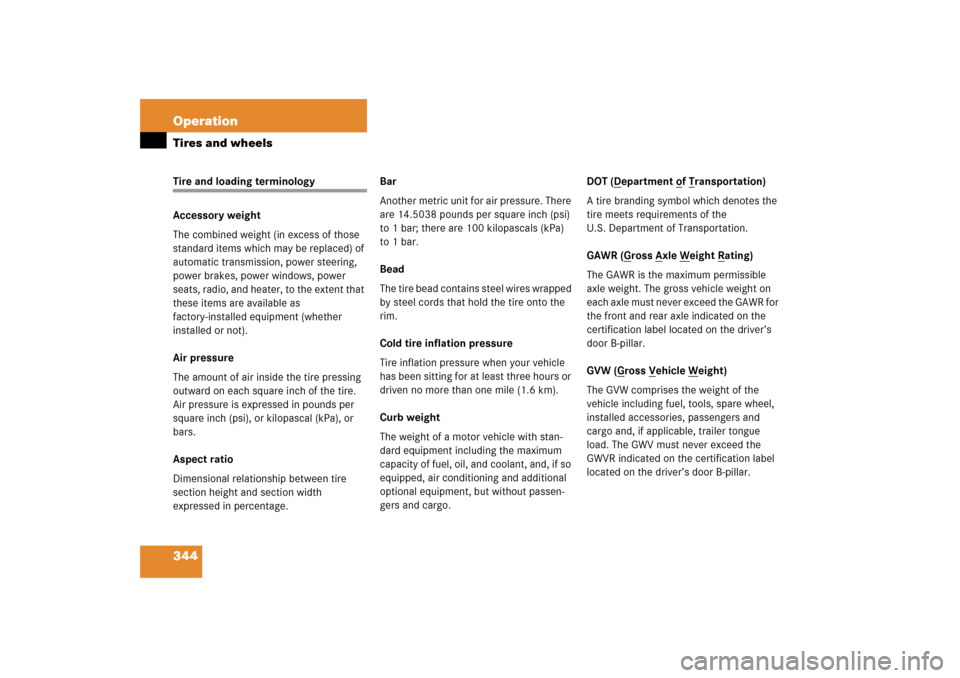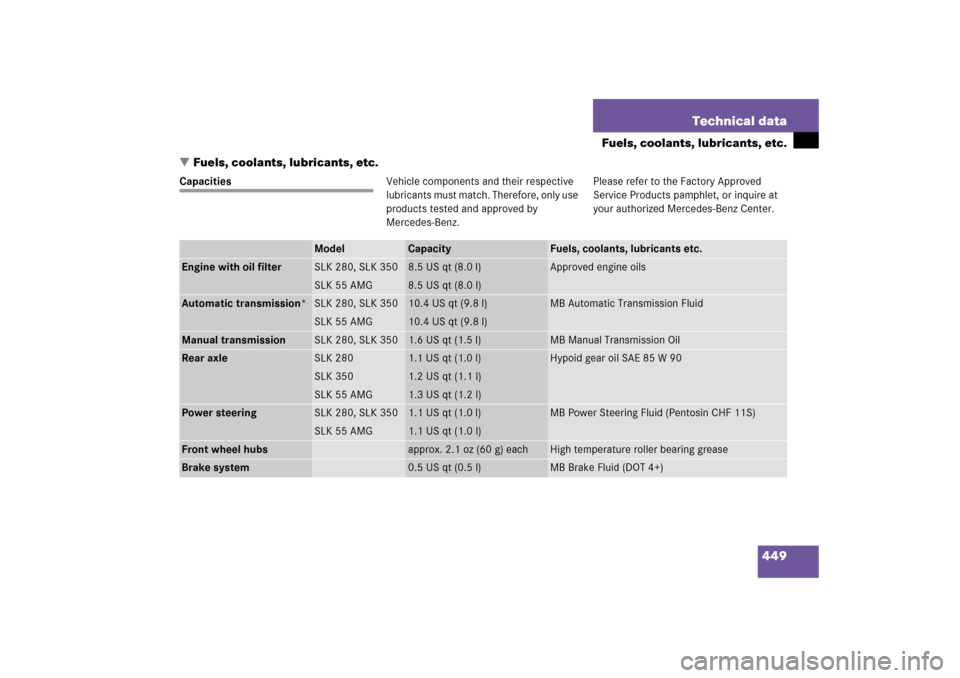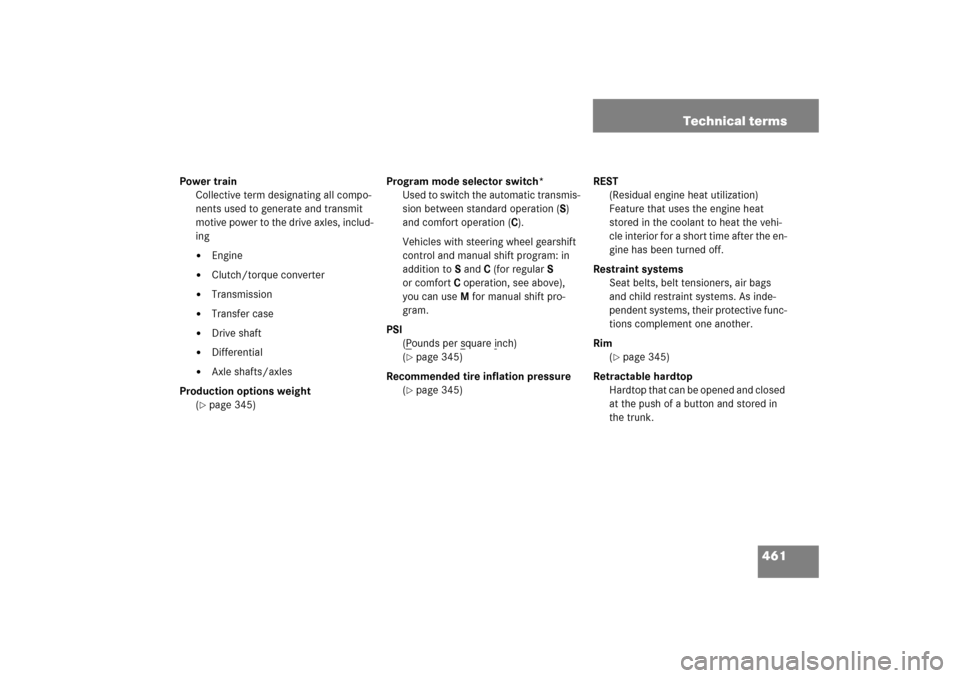Page 290 of 481
289 Controls in detail
Useful features
Switching off�
Turn switch at tip of lever in direction of
arrow3 and release it.
The steering wheel heating is switched
off. Indicator lamp2 goes out.iIndicator lamp2 flashes or switches
off in case of�
power surge or undervoltage
�
steering wheel heating malfunction
iThe steering wheel heating switches off
automatically when you remove the
SmartKey from the starter switch.
Page 294 of 481

293 Operation
Driving instructions
�Driving instructions
Drive sensibly – save fuel
Fuel consumption, to a great extent, de-
pends on driving habits and operating con-
ditions.
To save fuel you should:�
Keep tires at the recommended infla-
tion pressures.
�
Remove unnecessary loads.
�
Allow engine to warm up under low
load use.
�
Avoid frequent acceleration and decel-
eration.
�
Have all maintenance work performed
at the intervals specified in the
Maintenance Booklet and as required
by the maintenance service indicator.
Contact an authorized Mercedes-Benz
Center.
Fuel consumption is also increased by driv-
ing in cold weather, in stop-and-go traffic,
on short trips and in hilly area.
Drinking and driving
PedalsPower assistance
Warning!
G
Drinking and driving and/or taking drugs
and driving are very dangerous combina-
tions. Even a small amount of alcohol or
drugs can affect your reflexes, perceptions
and judgment.
The possibility of a serious or even fatal ac-
cident are greatly increased when you drink
or take drugs and drive.
Do not drink or take drugs and drive or allow
anyone to drive who has been drinking or
taking drugs.
Warning!
G
Keep driver’s foot area clear at all times. Ob-
jects stored in this area may impair pedal
movement.Warning!
G
With the engine not running, there is no
power assistance for the brake and steering
systems. In this case, it is important to keep
in mind that a considerably higher degree of
effort is necessary to brake and steer the ve-
hicle.
Page 345 of 481

344 OperationTires and wheelsTire and loading terminology
Accessory weight
The combined weight (in excess of those
standard items which may be replaced) of
automatic transmission, power steering,
power brakes, power windows, power
seats, radio, and heater, to the extent that
these items are available as
factory-installed equipment (whether
installed or not).
Air pressure
The amount of air inside the tire pressing
outward on each square inch of the tire.
Air pressure is expressed in pounds per
square inch (psi), or kilopascal (kPa), or
bars.
Aspect ratio
Dimensional relationship between tire
section height and section width
expressed in percentage.Bar
Another metric unit for air pressure. There
are 14.5038 pounds per square inch (psi)
to 1 bar; there are 100 kilopascals (kPa)
to 1 bar.
Bead
The tire bead contains steel wires wrapped
by steel cords that hold the tire onto the
rim.
Cold tire inflation pressure
Tire inflation pressure when your vehicle
has been sitting for at least three hours or
driven no more than one mile (1.6 km).
Curb weight
The weight of a motor vehicle with stan-
dard equipment including the maximum
capacity of fuel, oil, and coolant, and, if so
equipped, air conditioning and additional
optional equipment, but without passen-
gers and cargo.DOT (D
epartment o
f T
ransportation)
A tire branding symbol which denotes the
tire meets requirements of the
U.S. Department of Transportation.
GAWR (G
ross A
xle W
eight R
ating)
The GAWR is the maximum permissible
axle weight. The gross vehicle weight on
each axle must never exceed the GAWR for
the front and rear axle indicated on the
certification label located on the driver’s
door B-pillar.
GVW (G
ross V
ehicle W
eight)
The GVW comprises the weight of the
vehicle including fuel, tools, spare wheel,
installed accessories, passengers and
cargo and, if applicable, trailer tongue
load. The GWV must never exceed the
GWVR indicated on the certification label
located on the driver’s door B-pillar.
Page 428 of 481

427 Practical hints
Towing the vehicle
Warning!
G
If circumstances require towing the vehicle
with all wheels on the ground, always tow
with a tow bar if:�
the engine will not run
�
there is a malfunction in the power sup-
ply or in the vehicle’s electrical system
as that will be necessary to adequately con-
trol the towed vehicle.
Prior to towing the vehicle with all wheels on
the ground, make sure the SmartKey is in
starter switch position2.
If the SmartKey is left in starter switch
position0 for an extended period of time, it
can no longer be turned in the switch. In this
case, the steering is locked. To unlock, re-
move SmartKey from starter switch and re-
insert.
Warning!
G
With the engine not running, there is no
power assistance for the brake and steering
systems. In this case, it is important to keep
in mind that a considerably higher degree of
effort is necessary to brake and steer the ve-
hicle. Adapt your driving accordingly.iTo signal turns while being towed with
the hazard warning flasher in use,
switch on ignition and activate the
combination switch for the left or right
turn signal in the usual manner – only
the selected turn signal will operate.
Upon canceling the turn signal, the haz-
ard warning flasher will operate again.
!When towing the vehicle with all wheels
on the ground, please note the follow-
ing:
With the automatic central locking acti-
vated and the SmartKey in starter
switch position2, the vehicle doors
lock if the left front wheel as well as the
right rear wheel are turning at vehicle
speeds of approx. 9 mph (15 km/h) or
more.
To prevent the vehicle door locks from
locking, deactivate the automatic cen-
tral locking (
�page 101).
Switch off the tow-away alarm
(
�page 88).
The vehicle should only be towed using
a properly installed towing eye bolt.
Never attach a tow cable, tow rope or
tow rod to the vehicle chassis, frame or
suspension parts.
Page 438 of 481
437 Technical data
Layout of poly-V-belt drive
�Layout of poly-V-belt drive
SLK 280, SLK 350
1Idler pulley
2Idler pulley
3Automatic belt tensioner
4Power steering pump
5Air conditioning compressor
6Crankshaft
7Coolant pump
8Generator (alternator)
SLK 55 AMG
1Automatic belt tensioner
2Power steering pump
3Air conditioning compressor
4Crankshaft
5Coolant pump
6Generator (alternator)
7Idler pulley
Page 450 of 481

449 Technical data
Fuels, coolants, lubricants, etc.
�Fuels, coolants, lubricants, etc.
CapacitiesVehicle components and their respective
lubricants must match. Therefore, only use
products tested and approved by
Mercedes-Benz.Please refer to the Factory Approved
Service Products pamphlet, or inquire at
your authorized Mercedes-Benz Center.
Model
Capacity
Fuels, coolants, lubricants etc.
Engine with oil filter
SLK 280, SLK 350
8.5 US qt (8.0 l)
Approved engine oils
SLK 55 AMG
8.5 US qt (8.0 l)
Automatic transmission*
SLK 280, SLK 350
10.4 US qt (9.8 l)
MB Automatic Transmission Fluid
SLK 55 AMG
10.4 US qt (9.8 l)
Manual transmission
SLK 280, SLK 350
1.6 US qt (1.5 l)
MB Manual Transmission Oil
Rear axle
SLK 280
1.1 US qt (1.0 l)
Hypoid gear oil SAE 85 W 90
SLK 350
1.2 US qt (1.1 l)
SLK 55 AMG
1.3 US qt (1.2 l)
Power steering
SLK 280, SLK 350
1.1 US qt (1.0 l)
MB Power Steering Fluid (Pentosin CHF 11S)
SLK 55 AMG
1.1 US qt (1.0 l)
Front wheel hubs
approx. 2.1oz (60g) each
High temperature roller bearing grease
Brake system
0.5 US qt (0.5 l)
MB Brake Fluid (DOT 4+)
Page 462 of 481

461 Technical terms
Power train
Collective term designating all compo-
nents used to generate and transmit
motive power to the drive axles, includ-
ing
�
Engine
�
Clutch/torque converter
�
Transmission
�
Transfer case
�
Drive shaft
�
Differential
�
Axle shafts/axles
Production options weight
(
�page 345)Program mode selector switch*
Used to switch the automatic transmis-
sion between standard operation (S)
and comfort operation (C).
Vehicles with steering wheel gearshift
control and manual shift program: in
addition toS andC (for regularS
or comfortC operation, see above),
you can useM for manual shift pro-
gram.
PSI
(P
ounds per s
quare i
nch)
(
�page 345)
Recommended tire inflation pressure
(�page 345)REST
(Residual engine heat utilization)
Feature that uses the engine heat
stored in the coolant to heat the vehi-
cle interior for a short time after the en-
gine has been turned off.
Restraint systems
Seat belts, belt tensioners, air bags
and child restraint systems. As inde-
pendent systems, their protective func-
tions complement one another.
Rim
(
�page 345)
Retractable hardtop
Hardtop that can be opened and closed
at the push of a button and stored in
the trunk.
Page 468 of 481

467 Index
Control system 123, 458
AUDIO menu 129
Convenience* submenu 147
Coolant temperature 128
Instrument cluster submenu 137
Lighting submenu 143
Maintenance service indicator 350
Menus 124
Messages in display 368
Multifunction display 123
Multifunction steering wheel 124
NAV* menu 132
Overview (Menus) 126
Overview (Settings submenus) 136
Resetting 134
Settings menu 134
Standard display 128
TEL* menu 151
Time/date submenu 139
Trip computer menu 149
Vehicle status message memory
menu 132
Vehicle submenu 147
Controller Area Network see CAN systemConvenience closing*
Power windows 249
Retractable hardtop 257
Coolant 313
Adding water 306
Anticorrosion/antifreeze 454
Fuels, coolants, lubricants, etc. 453
Technical data 449
Temperature 303
Temperature, checking (Control
system) 128
Corner-illuminating front fog lamps*
(Lighting) 115
Cruise control 260, 458
Display message 370
Cup holder 268
Curb weight 344
Customer Assistance Center see CACD
Date (Control system) 141, 142
Daytime running lamp mode 112
Control system 143
Deep water see Standing water
Defrosting
Rear window 177
Windshield (Automatic climate
control*) 197
Windshield (Climate control) 184
Department of Transportation see DOT
Difficulties with starting 52
Direction of rotation (Tires) 320
Display text see Messages in display
Doors
Control panel, overview 31
Entry lamps 119
Locking/unlocking from outside 95
Opening from inside 97
Unlocking with Tele Aid 280
DOT 344
Drink holder see Cup holder
Drinking and driving 293
Driver’s air bag see Air bags